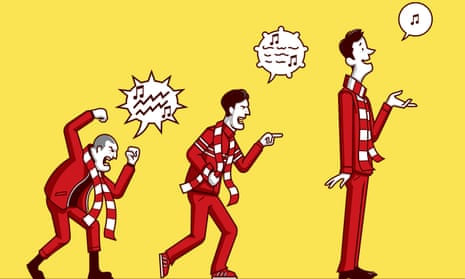There was an exciting announcement this week about a new style of shoe “inspired by 1980s terrace culture”. The idea behind the new shoe, an Adidas press release explained, is to capture the sights and sounds of English football 30 years ago. And who knows, it could work out well. Perhaps the new Adidas Widespread Racism will go on to become a huge hit.
This is of course a joke. The new shoe isn’t called the Adidas Widespread Racism. That would be ridiculous. Not to mention an insult to the hard-working team of marketeers and product developers behind the Adidas Piss Stink and its companion shoe, the Adidas Dart In The Eye.
That’s a joke as well! Not a very good one, and certainly not the kind of thing the Adidas Kamanda itself (real name) would appreciate, given it also represents “a statement against the superficial”.
It’s a good shoe too, with a swooping rubber soul and a knitted upper in a range of vibrant shades. It looks like a Cornish pasty filled with vomit – but in a good way.
It is also quite a funny concept if you experienced English football first-hand back in the pre-Premier League days. No doubt there were plenty of super-chic casuals out there, avatars of sharply dressed, beautifully alienated young manhood.
There was also quite a lot of decay and crumbling concrete, a muddle of noise and rain, old men with nicotine stained hair, mad-looking people in brown nylon trousers carrying plastic bags full of old newspapers. No doubt this is the kind of edgy look the shoe concept team has in mind when they say its aim is “to unite the underground subculture”.
The reason for dwelling on this here is that the current “terrace culture” was a sub-theme of two big Champions League matches in England this week. Both games were notable for the size the crowds, the high standard of football and the general feeling of a thrillingly well-run spectacle. Wembley was wild at times. Old Trafford rumbled and roared. Never mind willed nostalgia, that familiar old English vice. So many parts of watching football have got better with time.
Quick GuideFollow Guardian sport on social media
Show

Twitter: follow us at @guardian_sport
Facebook: like our football and sport pages
Instagram: our favourite photos, films and stories
There is one thing though, a tonal shift that has been creeping in for a while, and which was there in both Manchester and London this week. What has changed is the way an English football crowd talks to itself.
At the final whistle at Old Trafford I had a weird semi-deafness in my right ear. This was the ear that had been facing the Paris Saint-Germain fans, who ran through their repertoire of endless (often terrible) songs all night, most of which were basically about being a Paris Saint-Germain fan.
At Wembley the following night the Dortmund fans brought their travelling wall of flags, scarves and Rhineland noise. And once again the whole spectacle was a statement of their own identity, the shared joy of being part of that seething yellow block.

Yes, away fans are always noisier. Yes, crowds at the most expensive end of English football are greyer and more sedentary these days. But there is something new in the sound of the crowd, in the way it feels about itself.
The dominant note is snark and shade. Songs and shouts and chants tend to be outward-looking, to be directed at some hated opponent, present or otherwise. The shared playlist is a series of sneers and rage-blurts. Are you watching [insert name]? Person X was right, Related Entity Y is shite. Stand up if you hate [neighbouring Victorian community sports club turned distant global PLC].
At the Emirates last season, and at Wembley and Old Trafford this week, there have been moments when the home fans felt the need to respond to a noisy away end, have looked down, rooted around in the songbook and found … not much, weak beer, extended whinges that bubble up and simply fade away into the air.
You can see the tonal change when you look at old football on YouTube. Go back as far as the 1960s and people are often singing things like Here We Go and Eee Ai Addio We’ve Won The Cup, songs that are basically about the fun and the thrills of being in a big group of people.
Perhaps a part of this is a change in the way human beings gather together. Look at those pre-modern crowds and they’re rolling around shoulder to shoulder, drunk on collectivism, shared energy and cheap canned Dutch lager. There was something startlingly different in simply being around so many other humans. Even seeing the players was a thrill. Football, sport and public life existed only in the flesh.
Whereas now these things are always present, injected directly into your eyeballs via a constant bile-ridden digital drip. Little wonder there is a degree of radio interference. At times the stadium atmosphere can feel like football Twitter made flesh, one medium feeding another, learned habits seeping in from an increasingly angry and fractured public discourse, a place where all positions are defined by opposition, all talk is trash talk, a culture that is feasting on its own bones, enraged by its own component parts.
It is of course a familiar complaint down the ages. Things fall apart. The new is all tainted and toxic. Still, though, change is worth observing. And the crowd will remain a yeasty, fickle, responsive thing.
Right now one of its dominant notes in a strange moment for public life is shared impotent hostility. Which would, if the class of 2050 are reading this, make a pretty good name for a retro shoe when the time comes around to pore over the current age of rage.

